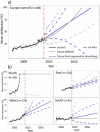European-wide forest monitoring substantiate the neccessity for a joint conservation strategy to rescue European ash species (Fraxinus spp.)
- PMID: 35306516
- PMCID: PMC8934346
- DOI: 10.1038/s41598-022-08825-6
European-wide forest monitoring substantiate the neccessity for a joint conservation strategy to rescue European ash species (Fraxinus spp.)
Abstract
European ash (Fraxinus excelsior) and narrow-leafed ash (F. angustifolia) are keystone forest tree species with a broad ecological amplitude and significant economic importance. Besides global warming both species are currently under significant threat by an invasive fungal pathogen that has been spreading progressively throughout the continent for almost three decades. Ash dieback caused by the ascomycete Hymenoscyphus fraxineus is capable of damaging ash trees of all age classes and often ultimately leads to the death of a tree after years of progressively developing crown defoliation. While studies at national and regional level already suggested rapid decline of ash populations as a result of ash dieback, a comprehensive survey at European level with harmonized crown assessment data across countries could shed more light into the population decline from a pan-European perspective and could also pave the way for a new conservation strategy beyond national boarders. Here we present data from the ICP Forests Level I crown condition monitoring from 27 countries resulting in > 36,000 observations. We found a substantial increase in defoliation and mortality over time indicating that crown defoliation has almost doubled during the last three decades. Hotspots of mortality are currently situated in southern Scandinavia and north-eastern Europe. Overall survival probability after nearly 30 years of infection has already reached a critical value of 0.51, but with large differences among regions (0.20-0.86). Both a Cox proportional hazard model as well as an Aalen additive regression model strongly suggest that survival of ash is significantly lower in locations with excessive water regime and which experienced more extreme precipitation events during the last two decades. Our results underpin the necessity for fast governmental action and joint rescue efforts beyond national borders since overall mean defoliation will likely reach 50% as early as 2030 as suggested by time series forecasting.
© 2022. The Author(s).
Conflict of interest statement
The authors declare no competing interests.
Figures






References
-
- Hill L, Jones G, Atkinson N, Hector A, Hemery G, Brown N. The£ 15 billion cost of ash dieback in Britain. Curr. Biol. 2019;29(9):R315–R316. - PubMed
-
- Pliûra A, Heuertz M. EUFORGEN Technical Guidelines for Genetic Conservation and Use for Common Ash (Fraxinus excelsior) Bioversity International; 2003.
-
- Dufour S, Piégay H. Geomorphological controls of Fraxinus excelsior growth and regeneration in floodplain forests. Ecology. 2008;89(1):205–215. - PubMed
-
- Mitchell RJ, Beaton JK, Bellamy PE, Broome A, Chetcuti J, Eaton S, Woodward S. Ash dieback in the UK: a review of the ecological and conservation implications and potential management options. Biol. Conserv. 2014;175:95–109.
-
- Przybył K. Fungi associated with necrotic apical parts of Fraxinus excelsior shoots. For. Pathol. 2002;32(6):387–394.
Publication types
MeSH terms
LinkOut - more resources
Full Text Sources
Research Materials
Miscellaneous

